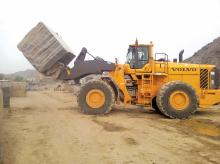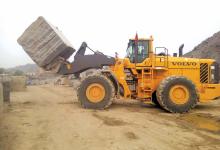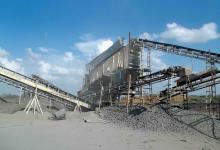
An investment of over US$500 million in a new tyre plant is a signal that Indian company BKT intends to meet its ambitious global targets over the next few years.
It sees major growth coming in the mining and quarrying markets and is hoping that eventually 40-50% of its income will be from this business. The recent huge investment at its Bhuj, northern India plant (see separate story), is part of increasing spending in the nation, which is already the second largest user of aggregates behind China.
Indeed, India is one of the world’s fastest-growing economies, and it has been predicted that by 2020 it could be a
US$5 trillion economy, up there with the US, China and Japan. According to the Indian Ministry of Mines, India produces as many as 87 minerals, which include four fuel; ten metallic; 47 non-metallic; three atomic and 23 “minor minerals” including building and other minerals, with the mining and quarrying sector estimated to account for 2.5% of India’s GDP.
And
For example, the Indian rigid tipper truck market is seeing Indian and foreign manufacturers introduce newer products, featuring refined engineering attributes for the fast-growing quarry sector. Newer trucks are being broadly engineered to suit the growing requirements of combined mode applications of the quarries; for loading and tipping granular sub-base materials, final crushed aggregates and manufactured sand within the mineral processing sites and for transporting the materials along roads.
Exports have increased significantly as Pearl continues to send Indian granite to its client base in China, Singapore, Italy, Malaysia, Indonesia, Korea, Ireland, Romania, UAE, Australia and the US.
Panchami Stone’s Sandvik Construction UH311 cone crusher and a UV312 VSI were acquired in 2014 and 2015 respectively, the latter being fitted with Sandvik’s state-of-the-art CV218 VSI, “which has proved ideal for manufacturing a superior sand product.”
Panchami Stone says it has also benefitted from improved production, reduced emissions and a lower cost per tonne operation.
Meanwhile, Indian marble is also finding a market worldwide, with 2014 figures showing that it was the tenth largest marble exporter (exporting 1.4% of production), realising over US$35 million from sales. This is set to increase.
Cement is also a major product in India where, among recent activity, the Birla Corp is buying the cement business of Reliance Infrastructure (R-Infra) for INR 48 billion (US$707 million), and will use the proceeds to reduce its debt.
In its recent report, World Cement & Concrete Additives, The Freedonia Group, a Cleveland, US-based industry market research company (www.freedoniagroup.com), says that despite a more challenging economic environment, demand for cement and concrete additives in China will grow through 2019.
The report predicts that China’s role as the leading driver of global cement and concrete additives demand growth will diminish, as the importance of markets in other developing countries such as India and Turkey continues to grow.
Meanwhile, the Federation of Indian Granite and Stone Industry, which aims to promote its members products across the globe and also to resolve many domestic problems faced by the industry in India, attracted some 300 exhibitors to its Stona 2016 Fair.
With some 900 members, the organisation has acquired state-of-the-art technology on a par with other countries, and its products are accepted worldwide and are being used in many big projects. India exports to more than 90 countries and granite processing machinery is also being manufactured in India.
The association says that due to its efforts, India has become the seventh largest exporter after China, Italy, Turkey, Egypt, Greece and Brazil.
“We have the largest resources of granite and natural stones. If the right policies are introduced we can become the top exporter with the support of the government,” says the association, which claims “India is the treasure trove of stone deposit in the world. India probably has the largest reserves of granites and natural stones in the world.”
India accounts for 20% of the total world reserves of granite, marble, sandstone and slate (appriximately 1,690 million m3).
“Unfortunately, the majority of the reserves are located in the forests and restricted hilly areas. Today, Karnataka, Andhra Pradesh, Tamil Nadu, Uttar Pradesh and Rajasthan are the top producers of granite and marble. Jharkhand, Chhattisgarh, Madhya Pradesh, Orissa and Gujarat are the emerging states. Because of various restrictions, such as poor state rules and environmental concerns, we are unable to increase the production,” says the association.
However, as The
Helping to produce these aggregates are many companies and equipment manufacturers such as
“Metso’s strong presence in the country and positioning in the markets together with India’s strong growth projections set the scene for future success,” says the company.
“Since its first deliveries in the 1980s to the inauguration of the latest multifunctional premises, Metso Park, in March 2010, Metso has been developing a strong relationship with India. Initially set up through a series of licences and joint ventures, the company established itself independently in 1992.”
The company says that the mining and construction segment is its fastest-growing customer segment in India, and its company Metso Minerals (India) claims market leadership in India in several product groups, including mobile crushing and screening plants; grinding mills; pyro-processing; coal washing; bulk material handling systems; recycling and waste management solutions and services.
LafargeHolcim’s CCI divestment order
LafargeHolcim has received a revised order from the Competition Commission of India (CCI) for the divestment of its interest in Lafarge India, including three cement plants and two grinding stations with a total capacity of around 11 million tonnes/year.
The company also markets aggregates and is one of India’s leading ready-mix concrete manufacturers.
The proposed transaction is an alternate remedy for the merger of the group’s legacy companies and now forms part of the company’s CHF 3.5 billion (US$3.35 billion) divestment target in 2016.
“We will operate in India through our subsidiaries ACC and Ambuja Cements with a combined cement capacity of around 63 million tonnes and a distribution network that extends across the entire country. We see opportunities to further build our business in India through our network of over 100,000 dealers and retailers, and by meeting the infrastructure needs of a country that is experiencing significant urbanisation,” says Eric Olsen, CEO LafargeHolcim.
The conditional clearance by the CCI for an earlier divestment proposal was received in April 2015; including the divestment of Jojobera and Sonadih plants in Eastern India with a cement capacity of 5.1 million tonnes.
LafargeHolcim subsequently entered into a letter agreement with Birla Corporation, subject to CCI approval, in August 2015. However, due to the current regulatory issues relating to the transfer of mining rights captive and critical to the two plants, LafargeHolcim was obliged to submit an alternate remedy to the CCI to ensure compliance with the order.
As a result, LafargeHolcim will now launch a new divestment process for Lafarge India.








